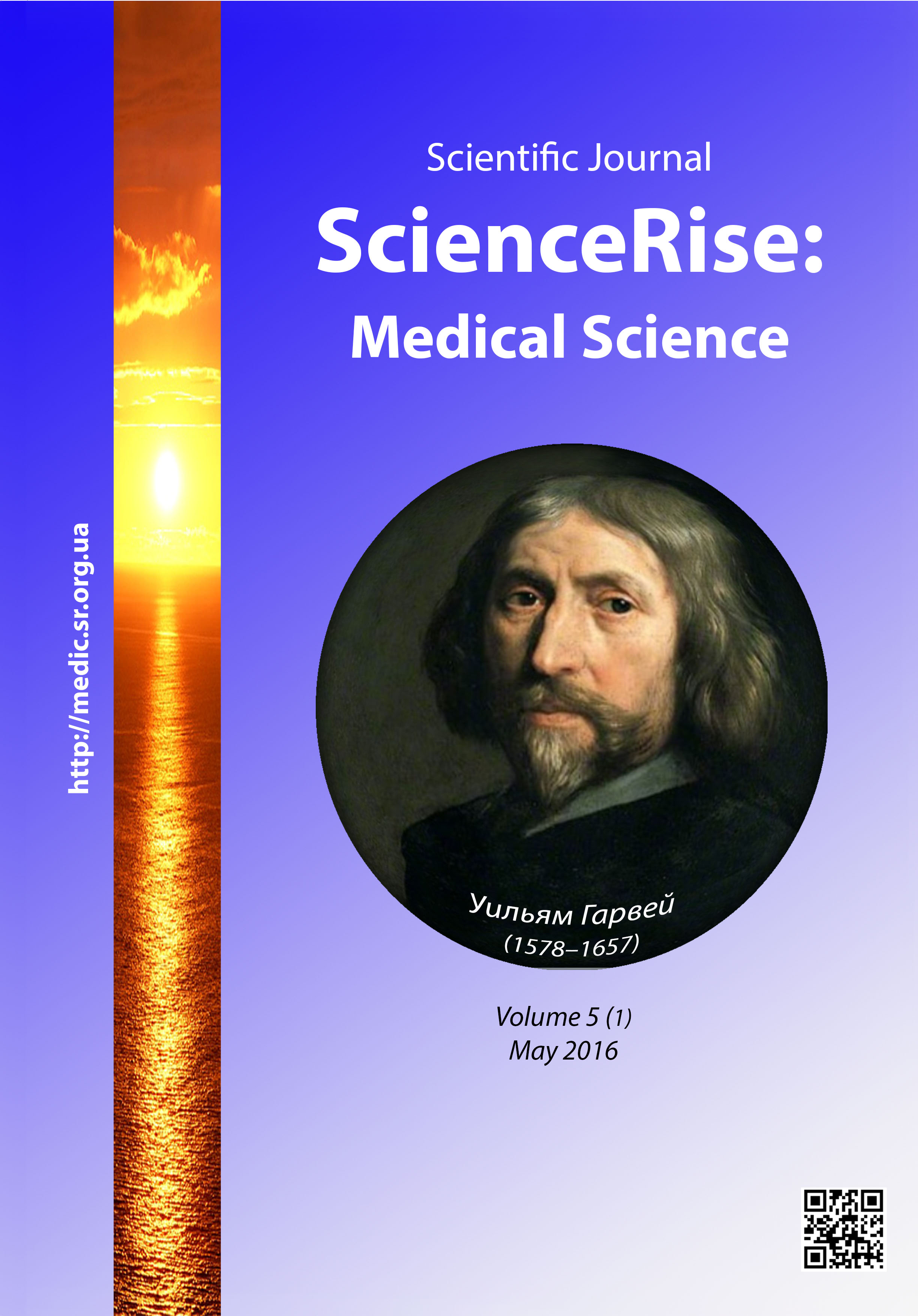Obsessive-compulsive phenomena in pathomorphosis of the simple form of schizophrenia
DOI:
https://doi.org/10.15587/2519-4798.2016.70125Keywords:
schizophrenia, simple form, obsessions, compulsions, pathomorphosis, psychodiagnosticsAbstract
Aim of the work – To establish the special features of obsessive-compulsive phenomena within pathomorphosis of the simple form of schizophrenia.
Materials and methods of research. On the base of MI “Regional clinic psychiatric hospital” of ZRC under condition of the informed consent were examined 58 patients with diagnosis – schizophrenia, simple form (F20.6), among them 31 men and 27 women. The mean age of patients were 42,4±0,82 years old. The duration of disease was 2–25 years.
Clinical-anamnestic, clinical-psychopathological, catamnestic and statistic methods were used in the research.
In the result of research was observed pathomorphosis of the simple form of schizophrenia. The analysis detected in the clinical picture not only classic manifestations such as autism, decline of energetic potential, emotional deficits and drifting, but also several pathologic syndromes that were earlier considered as not typical for this form of disease.
The classic picture of the simple form of schizophrenia realized with especially deficit symptomatology was present in 15,5 % of cases only. In more than ½ of observations in the structure of disease was present the productive symptomatology, the share of obsessive-compulsive inclusions within it was 10,3 %.
At the same time obsessive-compulsive phenomena often formed the clinical continuum in the debut of disease, in several cases they were kept during the whole disease and were reliably more often among the patients of male sex.
Conclusions. The results of research demonstrate the need for the further study of pathomorphosis of the psychic diseases for elaborating the more qualitative diagnostic criteria of comparing the obsessive-compulsive symptomatology with the different nosological unitsReferences
- Alekseeva, A. G., Tiganov, A. S. (2014). The typology of oneiroid-catatonic states in schizophrenia. Zhurnal Nevrologii i Psikhiatrii Im. S. S. Korsakova, 114 (12), 36. doi: 10.17116/jnevro201411412136-41
- Kovalev, V. V. (1989). Pathomorphosis of mental disorders: types and causes. Zhurnal nevrologii i psikhiatrii im. S. S. Korsakova, 89 (12), 51–55.
- Piven', B. N., Goldobina, O. A. (1997). The clinical pathomorphosis of neuroses. Zhurnal nevrologii i psikhiatrii im. S. S. Korsakova, 97 (11), 12–15.
- Tiganov, A. S. (2015). The pathomorphosis of schizophrenia. Zhurnal Nevrologii i Psikhiatrii Im. S. S. Korsakova, 115 (11), 3. doi: 10.17116/jnevro20151151123-5
- Oulis, P. (2013). Differential diagnosis of obsessive-compulsive symptoms from delusions in schizophrenia: A phenomenological approach. World Journal of Psychiatry, 3 (3), 50. doi: 10.5498/wjp.v3.i3.50
- Pinto, A., Steinglass, J. E., Greene, A. L., Weber, E. U., Simpson, H. B. (2014). Capacity to Delay Reward Differentiates Obsessive-Compulsive Disorder and Obsessive-Compulsive Personality Disorder. Biological Psychiatry, 75 (8), 653–659. doi: 10.1016/j.biopsych.2013.09.007
- Simpson, H. B., Reddy, Y. C. J. (2014). Obsessive-compulsive disorder for ICD-11: proposed changes to the diagnostic guidelines and specifiers. Revista Brasileira de Psiquiatria, 36, 3–13. doi: 10.1590/1516-4446-2013-1229
- Fountoulakis, K. N., Andreoulakis, lias E., Iacovides, A. (2013). Nonsensory Hallucinations or Obsessive Symptoms? The Journal of Nervous and Mental Disease, 201 (9), 818–823. doi: 10.1097/nmd.0b013e3182a21864
- Kuznetsova, V. I. (1979). Pathomorphology of the brains of schizophrenic patients treated with psychotropic drugs (concerning drug pathomorphosis). Zhurnal nevrologii i psikhiatrii im. S. S. Korsakova, 79 (7), 929–933.
- Khokhlov, L. K., Vorob'ev, M., Vinnikoova, I. M., Savel'ev, L. N. (1972). Pathomorphosis of schizophrenia. Zhurnal nevrologii i psikhiatrii im. S. S. Korsakova, 72 (12), 1841–1847.
- Levinson, A. I. (1976). Development of circularity as a manifestation of schizophrenic pathomorphosis. Zhurnal nevrologii i psikhiatrii im. S. S. Korsakova, 76 (12), 1843–1847.
- Morkovkin, V. M., Kaplin, G. P., Romel', T. E., Guberman, A. S., Mazurskiĭ, M. B. (1980). Pharmacotherapeutic pathomorphosis of schizophrenia. Zhurnal nevrologii i psikhiatrii im. S. S. Korsakova, 80 (5), 745–748.
- Ozola, M. I. (1970). A therapeutic pathomorphosis of schizophrenia proceeding with paranoid disorders. Zhurnal nevrologii i psikhiatrii im. S. S. Korsakova, 70 (4), 600–605.
- Smulevich, A. B., Vartanian, F. E., Zavidovskaia, G. I., Rumiantseva, G. M. (1971). Problems of pathomorphosis of schizophrenia connected with the use of psychotropic drugs. Vestn. Akad. Med. Nauk SSSR, 26 (5), 79–83.
Downloads
Published
How to Cite
Issue
Section
License
Copyright (c) 2016 Наталья Владимировна Данилевская

This work is licensed under a Creative Commons Attribution 4.0 International License.
Our journal abides by the Creative Commons CC BY copyright rights and permissions for open access journals.
Authors, who are published in this journal, agree to the following conditions:
1. The authors reserve the right to authorship of the work and pass the first publication right of this work to the journal under the terms of a Creative Commons CC BY, which allows others to freely distribute the published research with the obligatory reference to the authors of the original work and the first publication of the work in this journal.
2. The authors have the right to conclude separate supplement agreements that relate to non-exclusive work distribution in the form in which it has been published by the journal (for example, to upload the work to the online storage of the journal or publish it as part of a monograph), provided that the reference to the first publication of the work in this journal is included.









